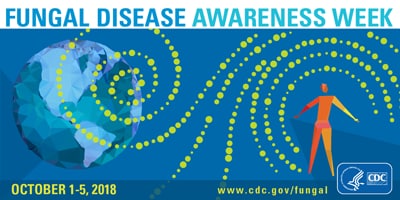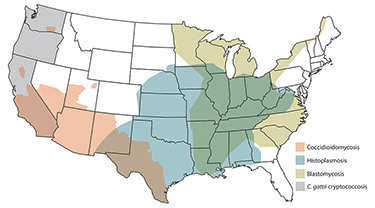Have you wondered about your chances of getting a fungal infection? Here are 10 questions you can use to understand fungal infections, learn how you can get sick, and know what you need to do to stay healthy.
Fungi are everywhere. There are millions of different species of fungi on Earth, but only about 300 of those are known to make people sick. Fungal infections are often caused by microscopic fungi that are common in the environment. Fungi live outdoors in soil and on plants and trees as well as on many indoor surfaces and on human skin.
Mild fungal skin infections can look like a rash and are very common. For example, ringworm is a skin infection that’s caused by a fungus, not a worm! Fungal infections in the lungs can be more serious and often cause symptoms that are similar to other illnesses, such as the flu or tuberculosis. Fungal meningitis and bloodstream infections are less common than skin and lung infections but can be life-threatening. Because the symptoms of fungal infections can be similar to other illnesses, proper diagnosis and treatment are often delayed. The more you know about fungal infections and your chances of getting one, the better prepared you can be to protect your health.
 Join CDC in sharing information to increase awareness in your community about fungal diseases during Fungal Disease Awareness Week, October 1-5, 2018.
Join CDC in sharing information to increase awareness in your community about fungal diseases during Fungal Disease Awareness Week, October 1-5, 2018.
10 Questions to Help You Learn Your Chance of Getting a Fungal Infection
- Where do you live and travel? Fungi that can cause serious infections are more common in some parts of the United States and world. For example, the fungus that causes Valley fever (also called coccidioidomycosis) is found mainly in the southwestern United States. Histoplasmosis and blastomycosis occur most often in the eastern United States. These infections usually cause a lung infection that is often mistaken for flu or a bacterial infection.
- What types of activities are you doing? Harmful fungi can be found in air, dust, and soil. Histoplasma grows especially well in soil that contains bird or bat droppings. Activities like digging, gardening, cleaning chicken coops, and visiting caves can result in you breathing in fungi that may cause infection.
- Do you have a dog or cat? People can get ringworm from their pets. Dogs and cats with ringworm sometimes have circular, hairless patches on their skin or other types of rashes. Adult animals do not always show signs of ringworm infection.
- Have you recently taken antibiotics? Antibiotics can make women more likely to get vulvovaginal candidiasis, also known as a vaginal yeast infection. Women who are pregnant and have weakened immune systems also are more likely to get this condition. Men also can get genital candidiasis.
- Are you taking any medications that affect your immune system? Medications used to treat conditions like rheumatoid arthritis or lupus may weaken your immune system and increase the chance of getting a fungal infection.
- Are you living with HIV/AIDS? People living with HIV/AIDS may be more likely to get fungal infections. Two well-known fungal infections associated with HIV/AIDS in the United States are oral candidiasis (thrush) and Pneumocystis pneumonia. Worldwide, cryptococcal meningitis is a major cause of illness in people living with HIV/AIDS.
- Will you be hospitalized? In the United States, one of the most common bloodstream infections in hospitalized patients is caused by a fungus called Candida. Candida normally lives in the gastrointestinal tract and on skin without causing any problems, but it can enter the bloodstream during a hospital stay and cause infection.
- Have you recently had a transplant? People who have recently had an organ transplant or a stem cell transplant have a greater chance of developing a fungal infection while their immune systems are weakened. Doctors prescribe antifungal medication for some transplant patients to prevent fungal infections from developing.
- Are you receiving chemotherapy or radiation treatments? Cancer treatment, such as chemotherapy and radiation, weakens your immune system and may increase the chance you will get a fungal infection.
- Do you have symptoms of pneumonia that are not getting better with antibiotics? Fungal infections, especially lung infections like Valley fever, histoplasmosis, and aspergillosis, can have similar symptoms as bacterial infections. However, antibiotics don’t work for fungal infections. Early testing for fungal infections reduces unnecessary antibiotic use and allows people to start treatment with antifungal medication, if necessary.
Anyone can get a fungal infection. You can learn more about the signs, symptoms, and treatment of fungal infections and get prevention tips by visiting CDC’s fungal diseases website and by talking with your healthcare provider.
